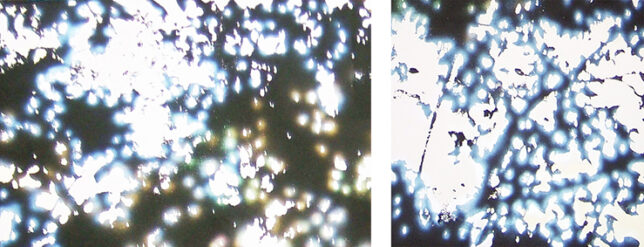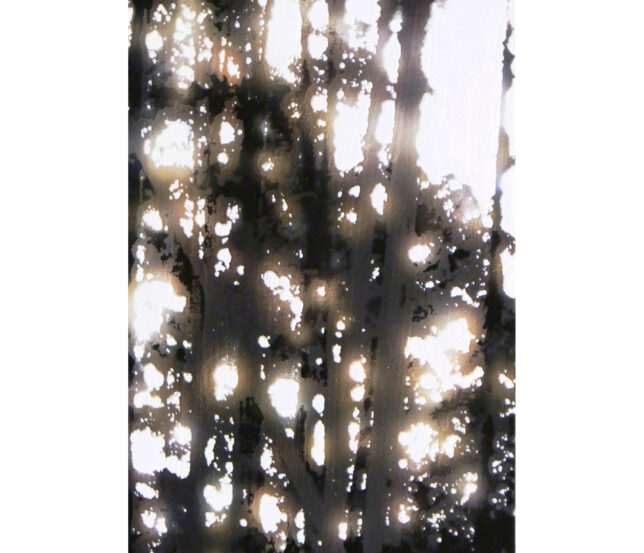新着情報

LEFT:Komorebi 23-Ⅲ(part)RIGHT:Komorebi 23-Ⅳ 2023
(Flowers Exhibition – Garden of Light 2023 ,2023 Jardin de Monet Marumottan au Village de Kitagawa, Kochi)

Komorebi,wailing(05-19) 2019 (FACE Exhibition 2020)
-644x479.jpg)
2017.9月-EDIT-644x366.jpg)
Kobayashi Gallery (Tokyo) 2017. September

コバヤシ画廊 Kobayashi Gallery 2005 (parts)

Komorebi 21-I 2021 (Kobayashi Gallery 2022)

Remm Hibiya (Tokyo) 2007. December
絵画が“光”を意識するとき、再び
“木漏れ日”を正確に表す言葉は英語圏に存在しませんが、そんな“木漏れ日”をテーマに継続して、二十数年になります。
僕の絵では、光を、希望の、ある種のメタファーとして表現しています。そして、希望はフィクションなので、意志を感じさせなければなりません。だからでしょうか。光は手彩色、つまり手で描いています。
光以外の部分はというと、リアルな世界の表現として、写真製版(シルク)を使っています。
これは、モティーフとしている植物が空に描き出すかたちの美しさには、人間の手技による再現など到底及ばない、という様な考えに至った経緯もあるのですが、それ以上に、光の表現の肉筆性を強調するためには、やはり、光以外は手で描いてはいけなかったということかもしれません。
そうして、その二つの表現のコントラスト、光VS影、自分の意志VS現実世界、手彩による光の肉筆性VS写真製版の即物性、あるいは「地と図」のたたかい、そのせめぎ合いのようなものが、時には作者である自分自身の予想を遥かに超えて、キャンヴァス上でさまざま繰り広げられる、そういうこと自体が絵の目的となっているような気がします。
手彩色ということで言えば、光の表現に、今はエアブラシを使っています。もともと筆で光を入れていたのですが、このエアブラシというツールは、植物のシルエットの美しさのようなものを決して邪魔しません。そっと寄り添う様なところが、筆との大きな違いです。
加えて、このツールには、例えば、印象派が実現した光の表現スタイルとは全く別の、今風の、クールで繊細、かつ哀愁のある光の表現ができるため、その意味で、僕自身はエアブラシにたいへん大きな可能性を感じています。こうして木漏れ日を続けているのも、このツールがあればこそ、と考えています。
[2020.12.27. 木俣 創志]
「FACE2020」SOMPO美術館におけるトークセッション [2020.2.14]
「INFINI vol.7」スペース・ゼロにおけるギャラリートーク [2020.12.20]
各内容に基づき編集
When art works find ‘light’again
“Komorebi”- literally means ‘sunbeams streaming through the leaves of trees’ but does not have the equivalent word in English- has been one of my main motifs for more than 20 years.
In “Komorebi”, I express ‘light’as the metaphor of ‘hope’, and as ‘hope’is fiction, I should convey‘my will’. Perhaps this is the reason I paint‘light’directly all by myself.
For almost all the other part of “Komorebi”works, I use photoengraving(silkscreen) to show the real world as it is.
One reason for it is that I once realized the silhouette of plants against the background of sky are too beautiful to depict by hands. The other one which is more important, is that leaving the other part printed out by silkscreen is the best way to emphasize ‘light’ of my own painting.
These two contrasting expressions: light versus shadow, my will versus real world, my own painting of ‘light’ versus photoengraving of concreteness, ground versus diagram, are confronting each other, and generating something appealing on every canvas, sometimes far beyond my expectations. This process itself seems to have been the aim of my works.
I now utilize airbrush handpiece to depict ‘light’, though I used to use paintbrushes before.‘Light’ painted by the tool never lessens the beauty of the plants silhouette as if nestling to it, which is the big difference from the one by paintbrushes.
In addition, with the tool, ‘light’ expressions can be up-to-date, cool, subtle, and sad, which largely vary from those completed by the Impressionists. I feel with the airbrush handpiece I can see much more room for the further depiction, and that will continue to make it possible for me to work on “Komorebi”.
[2020.12.27. Kimata Soushi]
Talk Session of “FACE2020” at Sompo Museum of Art [2020.2.14]
Gallery Talk of “ANFINI” vol.7 at Space Zero [2020.12.20]
Edit based on each content
絵画が“光”を意識するとき
太陽光が通過(passing through)した木の葉などの自然の形姿は、シルエットとしてそのディテールが省略され,平面化する。
絵画は前世紀において、自ら平面性を自覚し強調することで新たな生命を獲得してきたが、太陽光のような眩い光を背して平面化された自然界のイリュージョンには、いわゆる平面化というプロセス、あるいは平面化という“作為”そのものが存在しない。そうしたイリュージョンは我々人間の眼の仕組みに依拠し、アプリオリに成立するからである。
この“無作為の平面化”こそ、私の求める制作の方法論に最も合致するものではないか―
木漏れ日に揺らめく木々の様に、もののかたちが光を纏えば、そこには文学的な意味も賦与される。しかしながら、光を求めることは、きわめて造形的な必然性をも充たす。
ここには、これまで探求されてきたいかなる“平面化”とも本質的に異なる契機と可能性が満ち溢れている。
[2016.10.20. 木俣 創志]
When a painting is conscious of “light”
Natural shapes such as the leaves of trees which sunlight passes through are silhouetted and their details are omitted and flattened with human eyes.
In the last century, paintings themselves have acquired new lives by awareness of the flatness themselves, but in the planarization in which the illusion illuminated by flattening dazzling light like sunlight in the natural world, there is no process of planarization, or “act” of planarization itself. Because such an illusion depends on the mechanism of human eyes and is established a priori.
Isn’t this “planarization of no intentions” the most coincident with the methodology of my creation?
Like the trees that tremble in sunlight through the sun, shapes of things exposed to light, find a literary meaning to themselves. However, seeking light also fulfills extremely formative necessity.
Here, there are so many opportunities and possibilities that are basically different from any “flattening” that has been ever explored.
[2016.10.20. Kimata Soushi]
